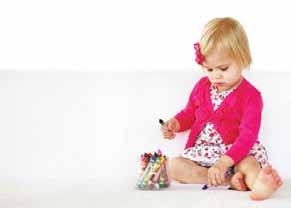
4 minute read
Emily Post published the first edition of the book on etiquette in 1922
Do As I Do
In 1993, basketball player, Charles Barkley really stirred the pot with his I am not a role model Nike ad. Maybe Charles isn’t, but honey, you have no choice! From the time you bring that precious wee one home, you are THE role model. All too soon your wee one will grow up and you’ll have to start worrying about outside influences, but for now make sure you are the model of manners you want your kiddo to emulate: pass the peas, please
• what’s that you say How you say something can be as important as what you say. The tone of your voice helps you express emotion and opinions. Loud, curt tones can portray anger, rudeness or disrespect. Are you always going to speak in a soft, soothing tone? Maybe if you live by yourself! No one is perfect, but you can be conscious of how you are talking to people and how they react to you. If you find you’re being a little rude, now’s the time to change your ways.
• thank you As your wee one starts to really interact with you, make sure you are using please and thank you as you talk directly to him.

No one ever thinks they are going to have the back talking kid they have seen at the grocery store. “My kid will NEVER…” Just remember the apple doesn’t fall far from the tree. If your manners are lacking, watch out for junior to follow suit.

Your tot is now able to partake in one the most valuable of family rituals. It has been around for decades and something passed down for generations… family mealtime. Yes, your tot is messy, maybe loud and not ready to sit much longer than it takes to finish his mac & cheese, but now is the time to start instilling table manners.
Obviously, you aren’t going to be teaching your tot the difference between the salad and dinner fork just yet, but he is ripe for learning the groundwork of mealtime etiquette. Just remember that it’s a marathon, not a sprint. Teaching table manners takes time and patience and you can’t get hung up on the occasional ill timed spill or burp. Here are some ways to introduce table manners:
• watch me Yep, sorry…you’re still on the hook. Make sure you model proper table manners and really be AT the table. No newspaper, phone or computer. Put all the distractions away and enjoy your time with the family.
• the rules Each family will have their own rules and expectations when it comes to table manners. Your tot isn’t going to understand the why behind the rules and that is fine. For now you are just introducing how things work in your house. Use polite words, but don’t hold back items if your tot doesn’t say please right away. Tots are notoriously strong willed and you don’t want to create a power struggle. Encourage your tot to use his polite words and when he does let him know it makes you happy.
• uh oh When your tot exhibits a behavior contrary to your table manners, such as throwing food, don’t get too worked up. Your tot loves attention and sometimes they don’t care how they get it, so make sure negative behavior doesn’t get any re-enforcing.

Instead use a firm, non-yelling voice to make your point clear, “No, throwing food.” rule for the ages
Remember that your tot is, well…a tot. He is still trying to master many skills needed for proper table manners such as fine motor skills and the ability to vocalize needs and wants. So, don’t expect the impossible. He is simply not going to be able to completely follow all the family rules at this time. Keep mealtime happy and enjoyable and as time goes by the table manners will fall into line.
Of course your preschooler wants to be the first in line, have all the toys to himself or have the most cake, but that wouldn’t always mean being polite. While these behaviors are tolerated at this age, it’s not too early to start molding that compassionate, tolerant adult you want to see in 15 years.


The Golden Rule, do unto others as you would have them do unto you, is often thought to be a religious value.
While it is associated with a number of world religions, it really offers a lesson in empathy and tolerance and dates back centuries. We all want our kiddos to be compassionate individuals and empathy and tolerance aren’t genes we’re born with. Here are some tips to help teach your kiddo to care about other’s feelings and to embrace differences:
• start with momma Be the example of how to treat other people. Make sure you are talking to and about people the way you want them to talk to and about you!
• daily lessons Take advantage of daily situations to talk about treating other people properly and that differences don’t mean wrong or bad. When a situation arises, whether it be on TV, in a book or your child isn’t acting appropriately take the opportunity to first, identify the inappropriate behavior. Then help your child consider the other’s feelings and how they would feel if it happened to them. Lastly, explain what the correct behavior would be in the situation. And when your child asks you questions about diversity, answer his questions honestly. Talking openly about differences let’s your child know it is acceptable to notice such things, but you have the opportunity to address how to handle those differences with respect.
• rude influences Our preschoolers are exposed to rude behavior everywhere they turn. From the playground to TV, you don’t have to look hard to find a sassy, back talking example. You aren’t able to monitor every person that enters your preschooler's world, but you can monitor the shows they are watching. Just because it’s on Disney doesn’t mean it is appropriate for your child. Pay attention to the rude behavior you can control and make it unavailable!


